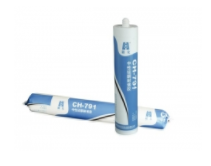The first is a non-sagging two-component polysulfide sealant, which has a delicate, uniform paste or viscous appearance. It is suitable for all kinds of deformation joints of cement buildings. Whether the deformation joints of buildings are vertical joints, ground joints, or top joints, it is applicable. When the sulphur seals are applied to the vertical joints or top joints of buildings, there will be no seals. The phenomenon of glue flowing from the construction joints falls down, but sticks directly to them. Therefore, the non-sagging two-component polysulfide sealant is especially suitable for the construction of vertical or top joints of buildings. The non-sagging two-component polysulfide sealant is oil-resistant, water-resistant, atmospheric-resistant, ultraviolet-resistant, impact-resistant, abrasion-resistant, high and low temperature resistant (-50). It is non-toxic and pollution-free. It is low modulus and high elongation. It is suitable for civil engineering, large water conservancy projects, water works, large sewage treatment plants, water supply and drainage, water conservancy projects and concrete projects such as building external hanging slabs. It has good bonding effect.
The deformation joint has the function of thermal expansion, cold contraction and synchronous coordination of deformation and displacement.
The second is self-leveling two-component polysulfide sealant, which is a kind of water-like liquid adhesive. Like water, it can flow in deformation joints and is relatively sparse. It is only suitable for the joints of cement building deformation joints and has flowability. After it is proportioned well, it can be directly poured into the ground joints and flow into the building deformation joints. In the construction of floor joints of buildings, the use of self-leveling two-component sealant saves time and effort. The self-leveling two-component polysulfide sealant is oil-resistant, water-resistant, atmospheric aging-resistant, ultraviolet-resistant, impact-resistant, abrasion-resistant, high and low temperature (-50 C-120 C) non-toxic and non-polluting. It belongs to low modulus, high elongation, and is suitable for cities. Deformation joints of ground, parking lot, water supply and drainage, Airport runway, concrete highway, pool bottom, underground engineering, hydraulic engineering, civil engineering and other horizontal concrete structures are sealed.

With the improvement of building decoration technology, the consumption of building adhesives has exceeded 400,000 tons, accounting for more than 30% of the total consumption of synthetic adhesives. It is estimated that by 2000, about 600,000 tons of building adhesives will be used, including 550,000 tons of decorative adhesives, 45,000 tons of sealants and 0.5 million tons of structural adhesives. The types of adhesives used for decorative adhesives and the proportion of their dosage will remain basically unchanged. Epoxy resin adhesives will still be used for structural adhesives, but the dosage will increase considerably and the amount of sealants will occupy. The proportion of total rubber will increase from about 30% to 60%, and become the leading product of building sealants in China, including 20,000 tons of silicone sealant and 0.5 million tons of polyurethane sealant.
At present, the adhesives produced in our country basically meet the needs of the development of domestic construction industry, but there is still a big gap in building sealants, structural adhesives and other aspects compared with foreign advanced products, so building silicone sealants and polyurethane sealants need to be imported. In the future, we should focus on the development of organic silicone sealant and polyurethane sealant, improve the quality of epoxy resin sealant, and further develop the market.